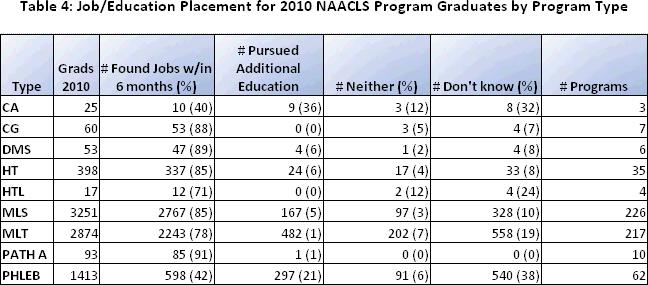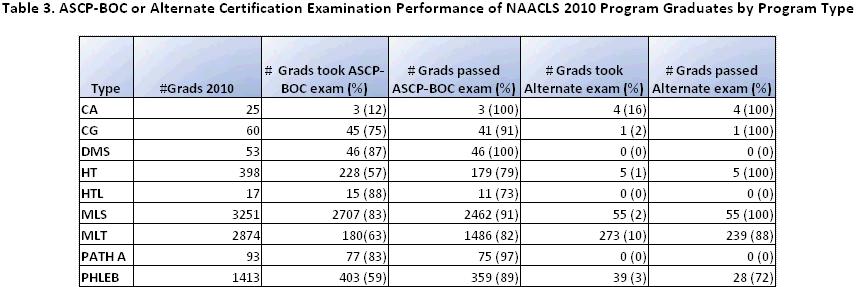NAACLS Programs, Graduates, Pass Rates and Placements: Findings from the 2011 Annual Survey of Programs
The Annual Survey of Programs, a collaborative effort of NAACLS, the ASCP-Board of Certification (ASCP-BOC), and the American Medical Association (AMA), was disseminated to program directors of 570 NAACLS accredited and approved programs. Submission of the completed survey is required annually by the Standards for NAACLS programs. Presented here are data indicating numbers of NAACLS accredited and approved programs and graduates, certification examination pass rates, and job and/or further education placement rates of graduates.
A longitudinal look at the numbers of programs and graduates by program type for the last 6 years appears in Table 1. Only modest changes in the numbers of programs (0 to 3) are indicated in each of the Clinical Assistant (CA), Cytogenetics (CG), Diagnostic Molecular Science (DMS), Histotechnician (HT), Histotechnology (HTL), Medical Laboratory Science (MLS), Pathologist Assistant (Path A) and Phlebotomy (PHLEB) levels. The number of accredited Medical Laboratory Technician (MLT) programs increased significantly by 11 programs from 206 in 2010 to 217 in 2011. Multi-location campuses and consortia have helped drive the increase in the number of MLT programs. The total number of accredited and approved programs in 2011 (570) increased by 18 over the 552 reported in 2010.

The trend towards increasing numbers of graduates reported for the 2009 and 2010 surveys continues in 2011 (Table 1). Fewer graduates were reported in 2011 compared to 2010 for the CG, HTL and PHLEB program levels but the smaller number of these program types does not easily allow statistical trend-spotting. For all the other program levels (CA, DMS, HT, MLS, MLT, and PathA) there was an increase in the numbers of graduates. For both DMS and HT programs, the increase in the number of graduates in 2011 compared to 2010 was over 10%. Once again the data suggest that, and anecdotal information supports, programs have increased enrollments through more effective student recruitment strategies, adaptations to education delivery models, and cultivation of clinical experience opportunities that allow greater numbers of students to complete programs.
The total number of programs and 2010 graduates are shown by program level and type of sponsoring institution in Table 2. Two-year colleges produce the largest number of CA and PHLEB graduates at 88% and 74%, respectively, with smaller numbers of graduates prepared at 4-year, hospital, or proprietary schools. Forty four (44) percent of CG graduates are prepared at academic health center/medical schools and 4-year institutions with 53% prepared at hospital programs. The greatest distribution of graduates across sponsoring institution types are HT and MLT graduates. For both these program levels graduates are prepared at 4-year, hospital, military, and 2-year institutions. In addition, some MLT graduates are prepared at academic health center/medical schools. All HTL and PathA graduates are prepared at academic health center/medical schools, 4-year institutions or hospital programs with none coming from military, proprietary or 2-year institutions. For MLT graduates, 77% are prepared at academic health center/medical schools or 4-year institutions with 23% from hospital or military programs.

The survey asked program directors to report on the number of graduates taking the ASCP-BOC or alternative certification examination and the number of examinees who passed (Table 3). Graduates from NAACLS accredited and approved programs are not required to take certification exams for successful completion of programs. Some graduates choose to delay taking examinations or elect not to do so and thus the number of examinees is less than the total number of graduates. Further, examinees are not required to release examination scores to their respective programs so for these examinees there are no available data. As seen in Table 3, 5329 examinees of 8184 graduates from all NAACLS accredited and approved programs in 2010 (from Table 2) or 65% took an ASCP-BOC certifying examination with the highest percentages of ASCP-BOC examinees reported from DMS (87%), MLS (83%) and PATH A (83%) programs and the lowest from CA (12%) and PHLEB programs (29%). The low percentage of CA and PHLEB examinees is probably the result of multiple certification examinations offered by different organizations and few or no employment consequences for the lack of professional credentials. It should be noted that a significant number of MLT graduates are prepared in military programs and are frequently immediately deployed after completion of the program. For these graduates, taking and passing certification exams is unlikely to be the highest priority of either the educational program or its graduates. The reported pass rates for examinees from all program types for ASCP-BOC certification exams were 80% or higher, with the exception of HT and HTL programs (79% and 73%, respectively). For these two program types it should be noted that the small number of programs and graduates makes statistical analyses difficult.
Program directors were asked to provide the numbers of graduates who found employment positions and/or pursued additional education within six months (Table 4). For some program types the numbers of graduates who secured employment and pursued additional education exceeded the total number of graduates suggesting that some graduates are both working and continuing their educations. The percentages of graduates employed within six months ranged from a high of 91% for graduates of PathA programs to a low of 40% for CA program graduates with most program types reporting placement rates of 75% or higher. CA and PHLEB programs reported the highest percentages of graduates pursuing additional education (36 and 21%, respectively) while CG and HTL programs reported no graduates pursuing additional education.

In summary, the number of NAACLS accredited and approved programs remains stable with the exception of a significant increase in the number of MLT programs. The numbers of program graduates increased again for the third year in a row. An acute national shortage of clinical laboratory professionals and greater demands for healthcare services continues as does the need for increased numbers of new laboratory professionals. Programs appear to be responding to that need by expanding enrollments. NAACLS graduates are prepared at a variety of sponsoring institution types including academic health center/medical schools, 4- and 2-year institutions, military and proprietary school programs. A significant percentage (35%) of new graduates did not take an ASCP-BOR certification examination with CA, HT, MLT and PHLEB program graduates representing the highest percentages of non-takers. For most program levels, the pass rates for ASCP-BOC examinees were above 80% indicating that programs are not only producing larger numbers of graduates but that these graduates are educationally well prepared. The placement rates for most program levels were 75% or higher indicating that program graduates enjoy high employability even during a period of high unemployment. Findings from the annual survey yield snapshots about programs, graduates, numbers of graduate per program, certification examination pass rate percentages, and placement rates.
by Dianne M. Cearlock, Ph.D., Chief Executive Officer
and Elizabeth Everson, Information Technology Manager
